Some of your coins might be worth more than you think! Nowadays, coins and currency are made out of material that is worth very little, its intrinsic value effectively zero, and the value printed on the note or coin backed purely by the authority of the US government. But that wasn’t always the case. Until the 1970s, some coins were fashioned using 90% silver, making them worth more than their face value thanks to the rise in value of precious metals.
Want to know how much they’re worth? Read on!
If you have a pile of old coins sitting in a jar, some of them might be worth more than their face value. If you have coins made out of 90% silver, don’t turn them in for their face value! You’ll want to separate them out and either keep them as a collectible, or cash them in for their intrinsic value with a gold and silver buyer like Cash for Gold Mailer.
Back when coins were brandished using silver, the intrinsic value of silver was much lower. As of writing this, the value of silver per ounce is just over $23.
Let’s take a look at the different common coins that are made of silver:
Silver dollars aren’t exactly popular legal tender these days, although the US Mint has tried to popular dollar coins over the years since (e.g. Sacagawea Dollars). So if you have any, you’re probably keeping them separate anyways.
But the reason they are actually worth more is because they were minted with a composition of 90% silver and 10% copper. That copper doesn’t carry much value, but at 90% silver, they’re worth much more than $1.
Morgan Silver Dollars and Peace Dollars are the most popular types of silver dollars.
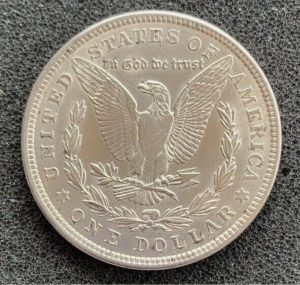
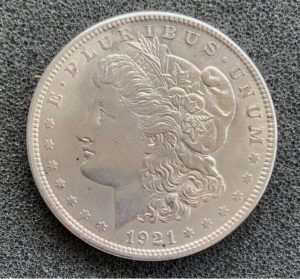
Morgan Silver Dollars were minted in the United States from 1878 to 1904, and then again in 1921.
1878-1904: Morgan Silver Dollars were produced regularly during this period.
1921: Morgan Silver Dollars were minted again in 1921 due to the passage of the Pittman Act, which authorized the melting and re-coining of silver dollars. This led to the production of Morgan Dollars for a brief period in that year.
These silver dollars are highly collectible, and their value can vary based on factors such as the year of minting, mintmark (if any), and the coin’s condition. They are often sought after by collectors for their historical significance and distinctive design. So, if you do have a Morgan Silver Dollar (or several), it’s important to check the mint marking before selling it. While many are just worth their silver value, those with rare mint markings (especially those that are in good condition) can be worth significantly more.
At Cash for Gold Mailer, we’re coin experts with decades in the business. Unlike other companies who might just pay you the intrinsic value of coins without checking, our knowledge of the coin market allows us to pay you more if you’ve got something rare and special on your hands.
Let’s calculate the intrinsic value of a basic Morgan Silver Dollar coin:
Weight: 26.73 grams, 0.859 troy ounces
Purity: 90% Silver
Current Price of Silver: $23.04/ounce
Value of a Morgan Silver Dollar: Weight in Troy Ounces * Purity * Price of Silver = (.859) x (.9) x ($23.04) = $17.78
Due to the collectible nature of Morgan Silver Dollars, they often fetch a premium of the secondary market, especially if they are in good condition. For this reason, at Cash for Gold Mailer, we guarantee an offer of 95% of the coin’s intrinsic value, but during times of high demand may pay even more.
Hint: The top 5 rarest Morgan Silver Dollars are the 1893-S, 1889-CC, 1895 (“King of Morgans”), 1884-S, and 1892-S mints. There are many more that are worth more than standard collectible value, so it’s still worth checking them first (or we will for you), but these are the most sought-after years and mintmarks.
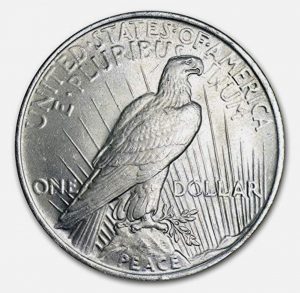
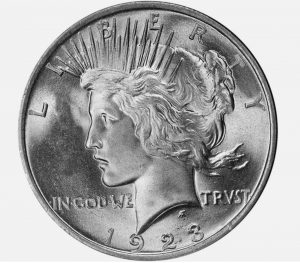
Succeeding the Morgan Silver Dollars, Silver Peace Dollars were minted from 1921 to 1928 and then again from 1934 to 1935. They were created to commemorate the end of WW1, or The Great War as it was known at the time.
1921-1928: Peace Dollars were initially minted during this period.
1934-1935: After a suspension in production, Silver Peace Dollars were minted again in 1934 and 1935.
The total mintage for Peace Dollars was relatively limited compared to other silver dollars, making them popular among collectors. The 1921 Peace Dollar is a particularly notable issue as it was the first year of production and is distinct from later issues in terms of design details.
Silver Peace Dollars were produced with the same standard production as Morgan Silver Dollars, meaning their contents are exactly the same: 90% silver, 10% copper, and a weight of 26.73 grams (0.859 troy ounces).
This means the intrinsic value of Silver Peace Dollars are the same as Morgan Silver Dollars.
Value of a Silver Peace Dollar: Weight in Troy Ounces * Purity * Price of Silver = (.859) x (.9) x ($23.04) = $17.78
Silver Peace Dollars are also highly collectible, so they can also fetch prices higher than the intrinsic value on the collector market. We keep this in mind at Cash for Gold Mailer. While we promise a minimum of 95% of the intrinsic value, we’ll often offer more based on the collectibles market.
Hint: The top 5 rarest Peace Silver Dollars are the 1928, 1934-S, 1921 High Relief Peace Dollar, 1922 High Relief Peace Dollar, 1927-D mintings. There are many more that are worth more than standard collectible value, so it’s still worth checking them first (or we will for you), but these are the most sought-after years and mintmarks.
Silver half dollars have been produced for over 100 years now, with them being worth little more than their legal tender for the past 50 years. For whatever reason, they haven’t really caught on, but the mint keeps producing them. As inflation has roared at the beginning of the 2020s, perhaps we’ll finally retire the penny and start using that section of change drawers for half dollars instead. But until that happens, half dollars have mostly proven to be ornamental.
That said, half dollars produced in 1970 and before are special because they are composed (at least partially) of silver, or may have some collector value. If you’re selling your gold and silver to us, it makes sense to include silver coins, as you’ll get more than $0.50 for them!
Here are a few of the more popular silver half dollars, including the Walking Liberties, Franklins, and Kennedy Half Dollars.
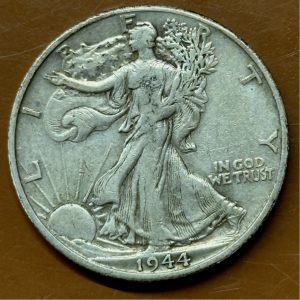
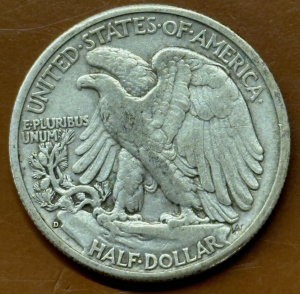
These were minted from 1916-1947, and are aptly named due to the picture of Lady Liberty walking on the front, along with an eagle on the back. They are often considered one of the most beautiful coins that the US has minted. Certainly more beautiful than the Roosevelt dime at least, if you ask us.
1916-1947: Walking Liberty Half Dollars were consistently produced for this 31 year period, undergoing no changes aside from the year and mint mark.
The production of these coins would become the standard production for Half Dollars until 1971, so the composition and silver value was set by the initial release. So, let’s calculate the intrinsic value of a Walking Liberty Half Dollar coin:
Weight: 12.5 grams, 0.3617 troy ounces
Purity: 90% Silver
Current Price of Silver: $23.04/ounce
Value of Walking Liberty Half Dollars: Weight in Troy Ounces * Purity * Price of Silver = (.3617) x (.9) x ($23.04) = $7.50
Walking Liberty Half Dollars are highly collectible and widely sought after by numismatists and coin collectors. These coins are admired for their artistic design, historical significance, and silver content. At Cash for Gold Mailer, we guarantee an offer of 95% of the coin’s intrinsic value, but during times of high demand may pay even more. We’re very knowledgeable about rarer mints and pay a premium for any coins with collectible value!
Hint: The top 5 rarest Walking Liberty Half Dollars are the 1921, 1938-D, 1921-D, 1919-D, and 1021-S variations. There are many more that are worth more than standard collectible value, so it’s still worth checking them first (or we will for you), but these are some of the most sought-after years and mintmarks.
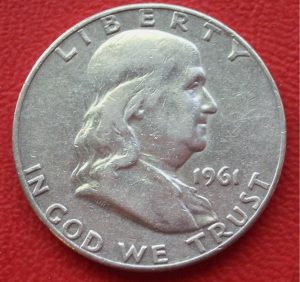
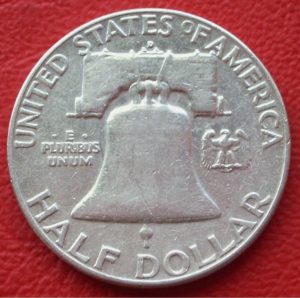
Franklin Half Dollars feature a portrait of Benjamin Franklin on the front, with the Liberty Bell on the back. They were minted after Walking Liberty Half Dollars stopped production, starting in 1948 and continuing until 1963.
1948-1963: Franklin Half Dollars were consistently produced for this 15 year period, undergoing no changes aside from the year and mint mark.
These coins have the same intrinsic value as the Liberty Half Dollars above and would use the same calculation.
Value of Franklin Half Dollars: Weight in Troy Ounces * Purity * Price of Silver = (.3617) x (.9) x ($23.04) = $7.50
Franklin Half Dollars are collectable, but they rarely fetch high prices like older or rarer coins. At Cash for Gold Mailer, we guarantee an offer of 95% of the coin’s intrinsic value, but during times of high demand may pay even more. We’re very knowledgeable about rarer mints and pay a premium for any coins with collectible value!
Hint: The top 5 rarest Franklin Half Dollars are the 1955 Micro-S, 1953-S, 1950-D, 1953-D, and 1952-S variations. There are many more that are worth more than standard collectible value, so it’s still worth checking them first (or we will for you), but these are some of the most sought-after years and mintmarks.
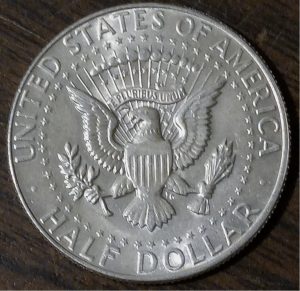
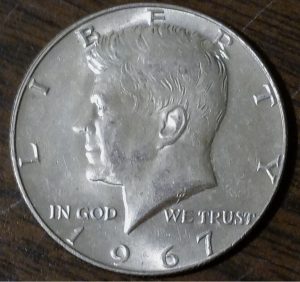
Kennedy Half Dollars started production in 1964, and as one might guess, feature the late John F. Kennedy. The production of these coins saw a shift from 90% silver like previous coins to 40% silver content, to being completely made of copper and nickel. Here is a breakdown of the production:
1964
The first year of issue for the Kennedy Half Dollar was 1964. These coins were made of 90% silver, similar to the composition of earlier silver coins.
These coins have the same intrinsic value as the half dollars above and would use the same calculation.
Value of a 1964 Kennedy Half Dollar: Weight in Troy Ounces * Purity * Price of Silver = (.3617) x (.9) x ($23.04) = $7.50
1965-1970
From 1965 to 1970, Kennedy Half Dollars were minted with a reduced silver content of 40%. These coins are often referred to as “40% silver” or “silver-clad” coins.
Let’s calculate the intrinsic value of a 1964 Kennedy Half Dollar coin:
Weight: 12.5 grams, 0.3617 troy ounces
Purity: 40% Silver
Current Price of Silver: $23.04/ounce
Value of a 1965-70 Kennedy Half Dollar: Weight in Troy Ounces * Purity * Price of Silver = (.3617) x (.4) x ($23.04) = $3.33
It’s tough to get too excited about, but $3.33 is still over 600% better than the $0.50 face value, so it’s worth separating them and selling them for their silver.
1971-Present
After 1970, Kennedy Half Dollars are composed of copper and nickel, making them non-silver coins. Without the high silver composition, they offer a negligible intrinsic value and no real collectable value either. In order for your Kennedy Half Dollars to be worth more than their face value, they need to have been minted before 1970. However, there have been special issues and collector sets with silver versions released in some years that we’ll cover below.
Kennedy Half Dollars are collectable, but they rarely fetch high prices like older coins. At Cash for Gold Mailer, we guarantee an offer of 95% of the coin’s intrinsic value, but during times of high demand may pay even more. We’re very knowledgeable about rarer mints and pay a premium for any coins with collectible value!
Hint: The top 5 rarest Kennedy Half Dollars are the 1970-D, 1987-P, 1998-S, 1974-D, and 1964 Accented Hair variations. There are many more that are worth more than standard collectible value, so it’s still worth checking them first (or we will for you), but these are some of the most sought-after years and mintmarks.
Kennedy Half Dollars are still being minted to this day, and they are intended to be used as currency (although they aren’t much). Over the years, there have also been several different special releases for collectors. Below, we’ll cover a few of those special editions of Kennedy Half Dollars:
Special Editions of Kennedy Half Dollars
Silver Proof Sets (1992-Present): The U.S. Mint has issued Silver Proof Sets annually, which include Kennedy Half Dollars struck in 90% silver. These sets typically consist of proof versions of circulating coinage. From an intrinsic value perspective, you would use the same calculation as the older mint coins. However, these have less collectible value and aren’t as rare, so it’s much less likely that you’ll have a coin worth more than its intrinsic or basic collectable value.
Special Mint Sets (1965-1967): During the years when regular mint sets were not produced, the U.S. Mint released Special Mint Sets. Kennedy Half Dollars in these sets were struck with a higher quality finish than regular circulating coins. Their value does not significantly differ from other coins produced during this period.
1976 Bicentennial Kennedy Half Dollar: In celebration of the United States Bicentennial, special Kennedy Half Dollars were minted in 1975 and 1976. The coins feature a dual date of “1776-1976” on the obverse. Made from copper and nickel, it has no intrinsic value.
200th Anniversary Coinage Set (1993): This set included a Kennedy Half Dollar struck at the West Point Mint with a “W” mintmark, making it the first time a Kennedy Half Dollar bore this mintmark. Made from copper and nickel, it has no intrinsic value.
50th Anniversary Gold Proof (2014): In 2014, the U.S. Mint issued a limited edition 50th Anniversary Kennedy Half Dollar Gold Proof. These coins were struck in 24-karat gold. Of course, these coins will be unmistakably gold in color, so they won’t get lost amongst a pile of basic Kennedy Half Dollars. But weighing in a .75 troy ounces and composed of 24 karat gold, this coin is much more valuable than typical silver dollars. With gold currently at $2042/ounce, the value would be:
Value of the 24k Gold Kennedy Proof: Weight in Ounces * Purity * Price of Gold= (.82285) x (1.00) x (2042) = $1680.26
2015 High Relief Gold Coin: To mark the 50th anniversary of the Kennedy Half Dollar, the U.S. Mint issued a special High Relief Gold Coin featuring the original 1964 design. Made from copper and nickel, it has no intrinsic value.
2022 Kennedy Half Dollar Reverse Proof Set: In 2022, the U.S. Mint released a special set containing Reverse Proof Kennedy Half Dollars, showcasing a reverse design inspired by the original 1964 high-relief design. Made from copper and nickel, it has no intrinsic value.
As long as they were produced in 1964 or earlier, silver half dollars are most likely to net you about $7.50 each. It’s always smart to check the year and mintmark to see if you have a rarer issue, thus increasing the collector value of the pieces. Even if you’re not an expert, you can find lists of rare combinations online or run searches for the coins you have to see if they turn up anything interesting. Or, you can just send them in to us for analysis. We’ll let you know if you have anything particular rare, explain our valuations, and make you an offer for your coins.
Quarters have been around for a long time. Since 1796, in fact. They were produced with 90% silver and 10% copper, a composition that continued until 1964. As you might imagine, early quarters wouldn’t be considered “common silver coins” and you just won’t find them in circulation anymore. They would have been removed for their collectable value long ago, or realistically they just wouldn’t have lasted this long. In fact, if you find a quarter from 1930 or earlier, it’s a collector piece and you wouldn’t want to sell it to us for its intrinsic value. Here’s a (very) fast overview of old quarters:
1796-1837: Early Draped Bust and Capped Bust Quarters were minted in various years during this period, and they were composed of 90% silver.
1838-1891: Seated Liberty Quarters, featuring Liberty seated on a rock, were minted during these years.
1892-1916: Barber Quarters, featuring the head of Liberty and a depiction of an eagle on the reverse, were minted during this period.
1916-1930: Standing Liberty Quarters were introduced in 1916 and underwent a design change in 1917 to address wear issues.
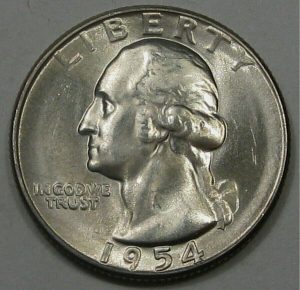
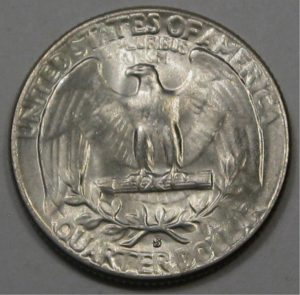
Washington Quarters were first minted in 1932 to celebrate his 200th birthday, and they’ve been the face of quarters ever since. And for that reason, Washington Quarters can sometimes slip into common change piles, as they have the same design as modern quarters. Of course they are 60+ years old now, so they may look a bit older, but the silver quarters are better than your average quarter!
1932-1964: Washington Quarters were first minted in 1932 to commemorate the 200th anniversary of George Washington’s birth. Until 1964, Washington Quarters were composed of 90% silver and 10% copper.
Let’s calculate the intrinsic value of a Washington Quarters (1932-1964):
Weight: 6.25 grams, 0.2009 troy ounces
Purity: 90% Silver
Current Price of Silver: $23.04/ounce
Value of a 1932-64 Washington Quarters: Weight in Troy Ounces * Purity * Price of Silver = (.1808) x (.9) x ($23.04) = $3.75
At 15x its intrinsic value, that’s a pretty good rate of return. So if you get one of these in your change after buying a coffee, you can basically buy another one for only a quarter!
Obviously, you won’t get rich finding a silver quarter, but they’re fun to look for and can add up. So if you have a few, you might as well send them in with your gold jewelry when you’re selling it!
Hint: A few Washington Quarters to look out for are the 1932-D, 1932-S, 1936-D, 1937-S, 1940-D, 1950 D/S Overmintmark, 1955, and 1955-D variations. Even if it’s not on this list, it’s still worth checking them first (or we will for you), but these are some of the most sought-after years and mintmarks.
In 1965, the U.S. Mint transitioned from silver to a copper-nickel clad composition for quarters as a cost-saving measure. Quarters minted from 1965 to 1970 do not contain silver and are commonly referred to as “clad” quarters. Over the years, other quarter variations have been created, such as the statehood quarters that feature designs of each state. Like the post-1964 Washington Quarters, they are made entirely of copper and nickel.
Dimes have been around since 1796, like quarters, and they follow a similar production trajectory. They were produced with 90% silver and 10% copper as well, and finally switched at the same time in 1964. Early dimes wouldn’t be considered “common silver coins” and you just won’t find them in circulation anymore. If you find a dime from 1916 or earlier, it’s a collector piece and you wouldn’t want to sell it to us for its intrinsic value. Here’s a (very) fast overview of collectable old silver dimes:
Draped Bust Dimes (1796-1807): The first silver dimes, known as Draped Bust Dimes, were minted from 1796 to 1807. These early dimes featured a design with a draped bust of Liberty on the obverse and a small eagle on the reverse.
Capped Bust Dimes (1809-1837): Capped Bust Dimes succeeded the Draped Bust design and were minted from 1809 to 1837. The design included Liberty with a Liberty cap on the front and a heraldic eagle on the back.
Seated Liberty Dimes (1837-1891): Seated Liberty Dimes were produced from 1837 to 1891. The design featured Liberty seated on a rock on the obverse and various designs on the reverse, including an eagle.
Barber Dimes (1892-1916): Barber Dimes, named after their designer Charles E. Barber, were minted from 1892 to 1916. The design included a bust of Liberty on the front and an agricultural wreath on the back.
On to more common silver coins. Mercy Dimes were first minted in 1916 and are the same color and shape as modern dimes, so you’ll occasionally find one in an old pile of change. Of course they are mostly 80+ years old now, so they may be a bit worse for the wear. Since Roosevelt Dimes look the same as modern dimes, it’s much easier for those to slip into your change. It’s a good habit to check the year of older looking dimes!
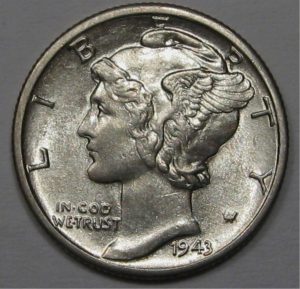
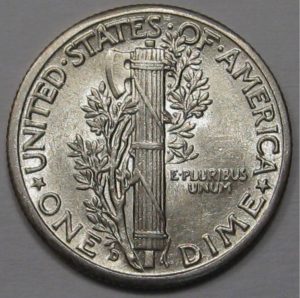
Mercury Dimes (1916-1945): Mercury Dimes, featuring a depiction of Liberty with wings on the front (though often mistaken for the god Mercury), were minted from 1916 to 1945. The reverse displayed a fasces and an olive branch. Since these look a bit more unique and are older, you’re less likely to find these since they are easier to identify as unusual.
Let’s calculate the intrinsic value of a Mercury Dimes:
Weight: 2.5 grams, 0.0834 troy ounces
Purity: 90% Silver
Current Price of Silver: $23.04/ounce
Value of a Mercy Dimes: Weight in Troy Ounces * Purity * Price of Silver = (.0834) x (.9) x ($23.04) = $1.73
Hint: A few Mercury Dimes to look out for are the 1916-D, 1921, 1926-S, 1930-S, 1931-D, 1942/1941 Overdates variations. Even if it’s not on this list, it’s still worth checking them first (or we will for you), but these are some of the most sought-after years and mintmarks.
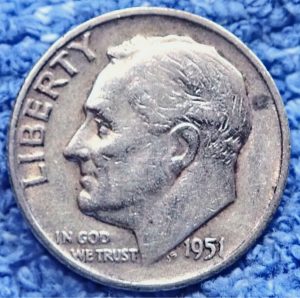
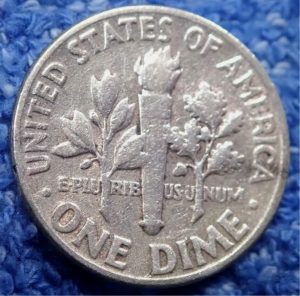
Roosevelt Dimes (1946-1964): The transition to clad coinage occurred after 1964 for circulating dimes, meaning dimes produced from 1946 to 1964 are composed of silver. Since they look just like current dimes, you’ll sometimes find these in circulation.
Roosevelt Dimes have the same weight and composition as Mercury Dimes, so the calculation is the same as above:
Value of a Roosevelt Dimes: Weight in Troy Ounces * Purity * Price of Silver = (.0834) x (.9) x ($23.04) = $1.73
At 17x its intrinsic value, that’s a pretty good rate of return. Worth picking out of your change, but it won’t add up too fast. If you have a few, you might as well send them in with your gold jewelry when you’re selling it!
Hint: A few Roosevelt Dimes to look out for are the 1950-S, 1955, 1964-D, 1964 Special Mint Set, and early proof issues. Even if it’s not on this list, it’s still worth checking them first (or we will for you), but these are some of the most sought-after years and mintmarks.
In 1965, the U.S. Mint transitioned from silver to a copper-nickel clad composition for quarters as a cost-saving measure. Quarters minted from 1965 to 1970 do not contain silver and are commonly referred to as “clad” quarters. Over the years, other quarter variations have been created, such as the statehood quarters that feature designs of each state. Like the post-1964 Washington Quarters, they are made entirely of copper and nickel.
While silver has increased in value over the years, its value for most common silver coins is still quite modest. Silver Washington Quarters and Mercury Dimes can be great finds that are worth more than their face value, and they’re totally worth including if you’re sending us gold or silver for cash.
Don’t underestimate what old coins could be worth either! Since we pay at least 95% of the value of gold and silver coins, you’re getting very good value for your metal value. Request a free mailer kit today to receive a free evaluation and see how much the value of your coins and other precious metals can add up!
To summarize, keep an eye out for the following common silver coins:
POSTED IN: Franklin Half Dollars, Kennedy Half Dollars, Mercury Dimes, Morgan Silver Dollars, Peace Silver Dollars, Silver Coins, Silver Dimes, Silver Dollars, Silver Half Dollars, Silver Quarters, Silver Roosevelt Dimes, Silver Washington Quarters, Value of Silver, Walking Liberty Half Dollars
By submitting your information you agree to our
Privacy
Policy and Terms and Conditions.


